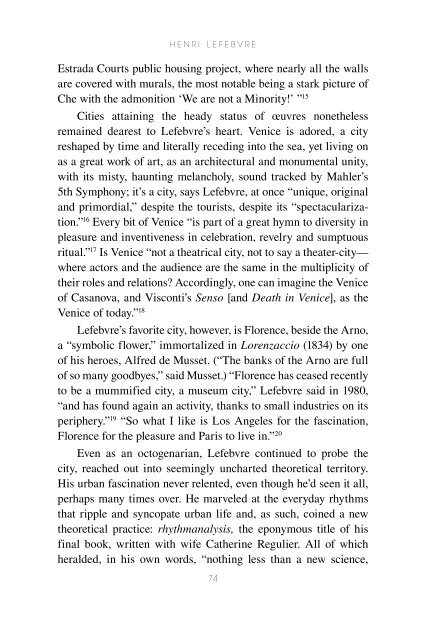Henri Lefebvre: A Critical Introduction - autonomous learning
Henri Lefebvre: A Critical Introduction - autonomous learning
Henri Lefebvre: A Critical Introduction - autonomous learning
Create successful ePaper yourself
Turn your PDF publications into a flip-book with our unique Google optimized e-Paper software.
H e n r i L e F e b v r e<br />
Estrada Courts public housing project, where nearly all the walls<br />
are covered with murals, the most notable being a stark picture of<br />
Che with the admonition ‘We are not a Minority!’ ” 15<br />
Cities attaining the heady status of œuvres nonetheless<br />
remained dearest to <strong>Lefebvre</strong>’s heart. Venice is adored, a city<br />
reshaped by time and literally receding into the sea, yet living on<br />
as a great work of art, as an architectural and monumental unity,<br />
with its misty, haunting melancholy, sound tracked by Mahler’s<br />
5th Symphony; it’s a city, says <strong>Lefebvre</strong>, at once “unique, original<br />
and primordial,” despite the tourists, despite its “spectacularization.”<br />
16 Every bit of Venice “is part of a great hymn to diversity in<br />
pleasure and inventiveness in celebration, revelry and sumptuous<br />
ritual.” 17 Is Venice “not a theatrical city, not to say a theater-city—<br />
where actors and the audience are the same in the multiplicity of<br />
their roles and relations? Accordingly, one can imagine the Venice<br />
of Casanova, and Visconti’s Senso [and Death in Venice], as the<br />
Venice of today.” 18<br />
<strong>Lefebvre</strong>’s favorite city, however, is Florence, beside the Arno,<br />
a “symbolic flower,” immortalized in Lorenzaccio (1834) by one<br />
of his heroes, Alfred de Musset. (“The banks of the Arno are full<br />
of so many goodbyes,” said Musset.) “Florence has ceased recently<br />
to be a mummified city, a museum city,” <strong>Lefebvre</strong> said in 1980,<br />
“and has found again an activity, thanks to small industries on its<br />
periphery.” 19 “So what I like is Los Angeles for the fascination,<br />
Florence for the pleasure and Paris to live in.” 20<br />
Even as an octogenarian, <strong>Lefebvre</strong> continued to probe the<br />
city, reached out into seemingly uncharted theoretical territory.<br />
His urban fascination never relented, even though he’d seen it all,<br />
perhaps many times over. He marveled at the everyday rhythms<br />
that ripple and syncopate urban life and, as such, coined a new<br />
theoretical practice: rhythmanalysis, the eponymous title of his<br />
final book, written with wife Catherine Regulier. All of which<br />
heralded, in his own words, “nothing less than a new science,<br />
74
















